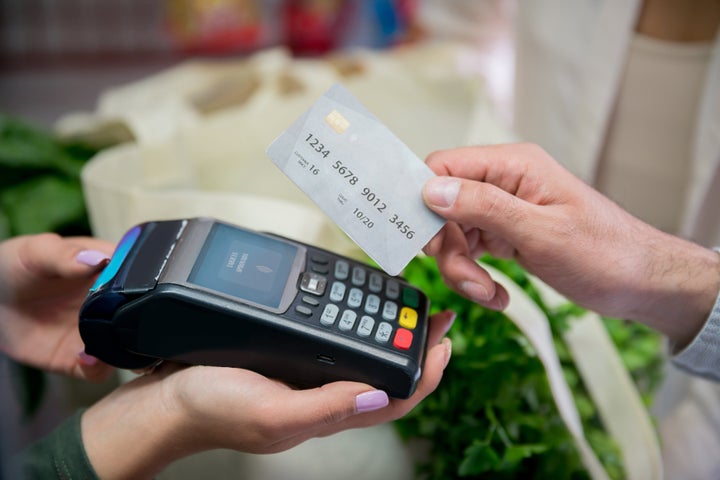
The Oklahoma winter wind made my eyes water as I steered my grocery cart toward the store entrance. I patted my coat pocket to reassure myself my WIC vouchers were in place and dipped my hand inside my purse until my fingers brushed the envelope with my grocery money.
Vouchers, check.
Grocery money, check.
Knot in stomach, check.
It was 1995 and I was poor.
I didn’t look poor. I was neat and clean with a neat, clean kid and a neat, clean car. My wool jacket was a holdover from a time I could afford expensive clothes. My daughter’s pink parka was from a bag of clothes my co-worker’s daughter had outgrown. We looked like people you’d meet at play group or book club.
We were barely scraping by.
I made enough for rent, utilities, insurance, and daycare, with about $70 left over each two-week pay period for groceries and gas. This included things like tampons and soap. I never filled my tank — five dollars here, two bucks in change there. Enough to get me to the next place I had to be. An unplanned car repair or an extra high gas bill would put me in the red.
Everything about grocery shopping is anxiety-inducing when you’re broke.
“Which was worse — running out of gas with a 3-year-old or having someone see me using vouchers to pay for groceries?”
This supermarket was 15 miles from my apartment. My chances of running into someone I knew were slim. The other side of the coin was that my car was almost on E. Which was worse — running out of gas with a 3-year-old or having someone see me using vouchers to pay for groceries?
I was a whisper above the poverty line. A recent cost-of-living raise had made me ineligible for SNAP, aka food stamps. I still had WIC — Women, Infants and Children — to supplement our groceries with items determined necessary for my daughter’s development: milk, juice, cheese, eggs, iron-fortified cereal.
On paper, I was not poor enough for SNAP, but the extra money in my paycheck never seemed to cover the same groceries I’d been able to get with food assistance. Although I was no longer a “food stamp shopper,” I had to try to make it through the checkout line without the embarrassment of asking the cashier to put something back because I didn’t have enough money.
WIC got us through some lean weeks. If things were tight, I’d buy macaroni and tuna for a little more variety than eggs or cereal for dinner every night. Our meals weren’t imaginative, but they were filling and semi-balanced.
I’d always choose my WIC items first and separate them from my other groceries. I was grateful for WIC, but I struggled using the program. I had to compare my voucher with the shelf label and pay attention to how many ounces were in my container of juice. Sometimes, things got shuffled around on the shelves, so I had to make sure I didn’t mistakenly grab the wrong item.
The memory of being chastised in a store crowded with after-work shoppers for grabbing the wrong cheese is vivid. I can see the cashier dangling the block of cheddar between her thumb and forefinger like a dirty sock. My eyes were fixed on the square of plastic pinned crookedly to the shoulder of her red smock. Her name was Amy.
”This is not WIC-approved cheese.”
She narrowed her eyes accusingly, like she’d caught me stealing. Her voice was louder than the voice she’d used to greet me a minute earlier. She addressed me as well as everyone else in line, as if it were critical to announce I was not only using food assistance but also incapable of using it correctly.
I was horrified and speechless.
“I can see the cashier dangling the block of cheddar between her thumb and forefinger like a dirty sock.”
She summoned a supervisor and voided the cheese with a sour expression. The friendly smile she’d worn before I presented my WIC voucher was gone.
I encountered many Amys during nine months of using SNAP benefits and three years of WIC. People made whispered — and not whispered — comments about what was in my shopping cart.
“If you’re using that,” a woman in line behind me gestured toward the cashier processing my WIC items while the rest of my groceries rested on the conveyor belt, “then I don’t understand why you’re buying those.” She wagged her fingers toward four Lean Cuisine meals stacked next to my other meager purchases: a bag of apples and store brand Tuna Helper. “How much rice and beans could you buy with what those cost?”
I knew they were a splurge. But I wanted my lunch to look like everyone else’s lunch. I wanted to casually pop my frozen lasagna into the microwave instead of pulling out another cheese sandwich.
I wanted those Lean Cuisines so badly that I skipped buying shampoo, which we were almost out of. I told myself I could make it last another week if I diluted it. I wondered if the woman who commented had ever had to choose between shampoo and food. I knew she wasn’t entitled to an explanation, but I wanted to give one. I couldn’t form the words.
Trying to get ahead — even just a little — seemed out of reach. Stocking my cupboards with sale merchandise was pie in the sky. What would it be like to have enough cans of diced tomatoes, pinto beans, and spices to make chili all winter? I was afraid to spend the extra money. What if I got a flat tire or needed to buy Tylenol?
Shopping trips were as much about stress and shame and scrutiny as they were about buying food. I constantly felt on the defensive, like I needed to validate myself to strangers. I wanted them to know I wasn’t lazy, that I worked hard. I could rarely buy what I wanted to eat and then I’d have to navigate a minefield at the checkout line. I’d often shake and sweat until I could escape to my car.
Tiny victories looked like finding extra money and splurging on a jar of jam or “the good hamburger.” Finding a name brand on sale for less than the store brand was celebration-worthy.
Thankfully, the lean years are far in the past, more than 25 years for me. Last week, I went to the store for cat food and laundry detergent. I rolled up to the checkout an hour later, my cart full of things I’d not planned to buy.
I caught a glimpse of 1995 me in the woman ahead of me. The familiar way of organizing purchases. The eggs, milk and off-brand cereal separated from the rest of her food. The tension in the way she held her body. The wary glance she gave me, as if trying to gauge if I was the sort who’d comment on her groceries.
There was, almost predictably, a snag with one of her transactions that required a supervisor. The supervisor — clearly not an Amy — resolved it quickly and kindly.
The person behind me warned another shopper that “This was not the line to be in” in a louder voice than necessary.
I turned to see the person who’d spoken, a middle-aged woman, like me. She smiled, like we were members of the same club. “How long do you think that’s going to take?” She gestured to the woman in front of us, in a voice so loud that it was clearly her intent for everyone to hear.
I ignored her, giving the woman in front of me and the cashier what I hope was an encouraging smile. Her relief was visible as the cashier handed over the receipt. She glanced apologetically at the growing line behind her, and then she was gone.
As the cashier rang up my purchases, it occurred to me I hadn’t checked any prices. My impulse items weren’t extravagant, but I’d tossed these things in my cart with zero regard for cost. I waited for my card to be approved with absolutely no fear it wouldn’t be.
The upcoming holidays are a good time to be mindful that many families struggle to get food on their tables. The person in front of you buying cheese with WIC vouchers deserves to be treated with dignity. The mom using SNAP has enough worries — one doesn’t need to be you staring at her Pop Tarts.
Most of us don’t see going grocery shopping sans anxiety as a blessing to count, but as someone who has been on the other side of that fence, I can tell you it absolutely is. Kindness and empathy are always in season.
Do you have a compelling personal story you’d like to see published on HuffPost? Find out what we’re looking for here and send us a pitch.
